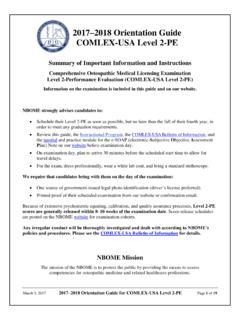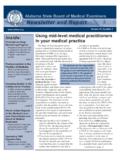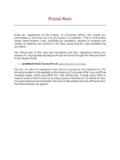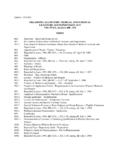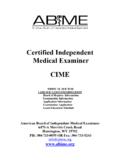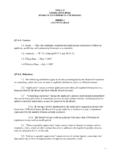Transcription of Fundamental Osteopathic Medical Competency Domains
1 Fundamental Osteopathic Medical Competency Domains Guidelines for Osteopathic Medical licensure and the Practice of Osteopathic Medicine National board of Osteopathic Medical examiners | June 2011. Fundamental Osteopathic Medical Competency Domains Fundamental Osteopathic Medical Competency Domains Guidelines for Osteopathic Medical licensure and the Practice of Osteopathic Medicine TABLE OF CONTENTS. OVERVIEW 3. INTRODUCTION 3. WHAT IS A PHYSICIAN Competency domain ? 6. Competency domain 1 Osteopathic Principles & Practice and Osteopathic Manipulative Treatment 7. REQUIRED ELEMENT Knowledge 7. REQUIRED ELEMENT Skills 8. REQUIRED ELEMENT Integration 9. Competency domain 2 Osteopathic Patient Care 10. REQUIRED ELEMENT Data Gathering 10. REQUIRED ELEMENT Differential Diagnosis 11. REQUIRED ELEMENT Procedures 11. REQUIRED ELEMENT Management 12. REQUIRED ELEMENT Osteopathic Principles & Practice and Health Promotion/Disease Prevention 13.
2 REQUIRED ELEMENT Patient Education 13. REQUIRED ELEMENT Teamwork/Documentation 14. Competency domain 3 Application of Knowledge for Osteopathic Medical Practice 15. REQUIRED ELEMENT Osteopathic Medical Knowledge Base 15. REQUIRED ELEMENT Physician Interventions 16. Competency domain 4 Practice-Based Learning and Improvement in Osteopathic Medicine 17. REQUIRED ELEMENT Fundamental Epidemiologic Concepts 17. REQUIRED ELEMENT Clinical Decision-Making Tools 18. REQUIRED ELEMENT Evidence-Based Medicine Principles and Practices 18. REQUIRED ELEMENT Clinical Significance of Research Evidence 19. REQUIRED ELEMENT Translating Evidence into Practice 19. REQUIRED ELEMENT Treating with Best Medical Evidence 19. REQUIRED ELEMENT Integrating Evidence into Clinical Practice 20. REQUIRED ELEMENT Continuous Evaluation and Improvement of Osteopathic Clinical Practice 20. Competency domain 5 Interpersonal and Communication Skills in the Practice of Osteopathic Medicine 21.
3 REQUIRED ELEMENT Eliciting Information 21. REQUIRED ELEMENT Rapport Building 22. REQUIRED ELEMENT Information Giving 23. REQUIRED ELEMENT Written and Electronic Communication 24. REQUIRED ELEMENT Interprofessional Team Collaboration 24. Competency domain 6 Professionalism in the Practice of Osteopathic Medicine 26. REQUIRED ELEMENT Knowledge 26. REQUIRED ELEMENT Humanistic Behavior 26. REQUIRED ELEMENT Primacy of Patient Need 27. REQUIRED ELEMENT Accountability 28. REQUIRED ELEMENT Continuous Learning 29. REQUIRED ELEMENT Ethics 29. REQUIRED ELEMENT Cultural Competency 30. REQUIRED ELEMENT Professional and Personal Self-Care 30. REQUIRED ELEMENT Honest, Transparent Business Practices 31. Competency domain 7 Systems-Based Practice in Osteopathic Medicine 32. REQUIRED ELEMENT Health Systems Organizations 32. REQUIRED ELEMENT Health Care System Interactions 32. REQUIRED ELEMENT Quality Cost-Effective Care 33.
4 REQUIRED ELEMENT Patient Advocacy 33. REQUIRED ELEMENT Health Care System Utilization and Patient Safety 33. REFERENCES 35. 2011 NBOME 2. Fundamental Osteopathic Medical Competency Domains OVERVIEW. This Fundam ental Osteopathic M edical Com petency Dom ains (FOMCD) 2011 Document represents expert consensus on the required elements and measurable outcomes for seven core Competency Domains as related to the practice of Osteopathic medicine. It considers these Domains predominantly from the assessment perspective, particularly as related to licensure for Osteopathic Medical practice. INTRODUCTION. Over the past 15 years, there has been a growing national and international trend toward developing frameworks for defining, applying, teaching, and measuring the Competency of a physician. Many organizations have developed criteria to define and measure Competency , stemming from efforts of the Royal College of Physicians and Surgeons of Canada (RCPSC) with their Skills for the New Millennium project, which eventually evolved into the CanMEDS Roles framework.
5 Following this seminal work, a number of organizations proposed physician Competency -based frameworks to guide their own efforts. These include, but are not limited to, the American Association of Colleges of Osteopathic Medicine (AACOM), the Association of American Medical Colleges (AAMC), the American Osteopathic Association (AOA), the Council on Osteopathic Postgraduate Training Institutions (COPTI), the American board of Medical Specialties (ABMS), the Federation of State Medical Boards (FSMB), the International Association of Medical Regulatory Authorities (IAMRA), the government ( pay for performance or P4P), third- party payers, and public interest groups. In addition to RCPSC efforts, the impetus toward Competency -based systems arguably stems from the 2001 report on Crossing the Quality Chasm, published by the Institutes of Medicine, the health arm of the National Academy of Sciences ( ).
6 In early 2006, the General Medical Council (GMC) of the United Kingdom also published a landmark document entitled Good Medical Practice (GMP). The GMC document describes the principles and values on which good Medical practice is founded and lists several duties that are expected of all physicians registered with the GMC. ( , good clinical care, relationships with patients, and working with colleagues). More recently, the FSMB and other organizations, including the AOA, the National board of Medical examiners (NBME), and the National board of Osteopathic Medical examiners (NBOME), have sponsored several Competency -accountability summits. The central theme that has prevailed in these summits is that of assessing and maintaining physician Competency throughout the practice career of the physician. One outcome of the second summit was the drafting of a theoretical textbook on Good Medical Practice USA to deliver a Competency -based curriculum.
7 The topics included the following: 1. Medical knowledge 4. Communication 2. Patient care 5. Practice-based learning 3. Professionalism 6. Systems-based practice More directly related to Osteopathic medicine, in its Report of the Core Competency Task Force, the AOA. offered a comprehensive list of competencies that encompasses all current published positions on this issue and includes those Domains that are uniquely tied to the Osteopathic Medical profession. Consequently, this AOA report served as the basis for the NBOME's initial report on competencies, The Seven Osteopathic Medical Competencies: Considerations for Future Testing and the Practice of Osteopathic Medicine (2006). A subsequent report, Fundamental Osteopathic Medical Competencies: Guidelines for Osteopathic Medical licensure and the Practice of Osteopathic Medicine, was released by the NBOME in 2009. 2011 NBOME 3.
8 Fundamental Osteopathic Medical Competency Domains In its 2006 and 2009 reports, the NBOME sought to more clearly define the Osteopathic Medical Competency Domains . The report also attempted to describe what measurable elements were available to assess the Competency Domains and what outcomes could be anticipated from the assessments. The NBOME recognized that different assessment tools might have to be applied at different times in the lifecycle of the physician. More recently, the NBOME, under the guidance of its Blue Ribbon Panel on Enhancing COMLEX-USA. (BRP), sought to further refine the competencies document, emphasizing updated terminology and measurement strategies and continuing the transformation of COMLEX-USA examinations to a Competency -based schema and construct. The NBOME hopes this document will prove thought provoking, and that it will continue to generate serious discussion on the direction that education, the profession, the regulatory authorities, and the public choose to take in regards to establishing the parameters for Osteopathic physician Competency .
9 The report is offered for use by all those considering methods and means for determining whether or not an Osteopathic physician possesses a measurable demonstration of sufficient knowledge, skill sets, experience, values, and behaviors that meet established professional standards, supported by the best available Medical evidence, and that are in the best interest of the patient's well-being and health. An addendum document focusing on measurement tools to consider for various Competency Domains and related outcomes and elements is currently under preparation and will be available in 2012. Material contained in this publication may be reproduced or utilized without the express permission of the NBOME. Please use the following attribution: NBOME Reprinted by permission. All rights reserved. The information contained in this report represents solely the opinion of the NBOME, and it should not be construed to necessarily reflect the content, scope, or format of any or all NBOME test instruments.
10 The following individuals served as the editing team for the FOMCD 2011: Editors-In Chief John R. Gimpel, DO, MEd, NBOME President & CEO. Andr De Champlain, PhD, NBOME Director for Innovations in Testing Janice Knebl, DO, MBA, NBOME Blue Ribbon Panel Chair, NBOME board Vice-Chair, University of North Texas Health Science Center at Fort Worth Section Editors John Bulger, DO, Geisinger Health System Richard J. LaBaere, II, DO, MPH, Mount Genesys Regional Medical Center John R. Gimpel, DO, MEd, The National board of Osteopathic Medical examiners John Goudreau, DO, PhD, Michigan State University-College of Osteopathic Medicine Erik Langenau, DO, The National board of Osteopathic Medical examiners Jim Nemitz, PhD, West Virginia School of Osteopathic Medicine John R. Potts, III, MD, University of Texas Medical School at Houston Karen Snider, DO, Still University of Health Sciences-Kirksville College of Osteopathic Medicine 2011 NBOME 4.


